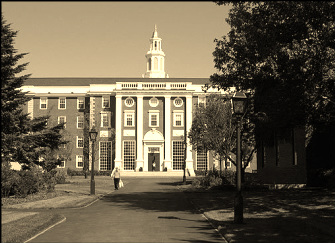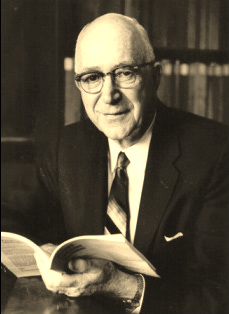Life at Harvard College

Spring 1954:
According to Blass, Milgram decided to apply to Harvard College's Ph.D. program in social psychology in Cambridge, Massachusetts shortly after learning about its Department of Social Relations graduate program from a dean who happened to overhear him giving a speech at Queens. Unfortunately, Milgram didn't realize the long road he'd have ahead of him. He was rejected from Harvard because he hadn't taken any psychology courses during his undergraduate career at Queens and hence, hadn't enough experience or knowledge to qualify for the program (13-14).
Blass says, soon after, Milgram wrote a letter to Harvard's Social Relations Department indicating his plan to take a psychology course that summer at Columbia University, and explaining his "intensive regimen of reading, directed by the chairman of the Department of Anthropology and Sociology at Queens College" (15). The chairman of the Social Relations Department's committee on Higher Degrees (the graduate program), "a pioneer in social psychology" (17), Gordon Allport, responded and told Milgram to apply to Harvard's Office of Special Students to catch up with his knowledge, and to then apply the next semester to be a regular student. On June 30, 1954, Milgram was admitted to Harvard as a special student (15).
That summer, Milgram enrolled himself in five psychology classes at three different schools. He took Psychology of Personality and an Eclectic Approach to Social Psychology at Brooklyn College, a General Psychology and Gestalt Approach to Social Psychology class at Hunter College, and audited a Child Psychology, and Language and Society class at New York University (Blass 15).
Blass said that that fall, when Milgram arrived at Harvard, he was much more educated in psychology than when he applied, and started his new academic career in Harvard's Department of Social Relations. In order to achieve his goal of becoming a regular student, Milgram had to take four courses that were requirements of the Ph.D. program, and pass their final exams. As expected, he passed the exams in social anthropology, clinical psychology, sociology, and social psychology with a B+, A, A- and A, and qualified to become a regular student for the 1955-1956 academic year. Milgram was finally a regular Harvard student (22-23).
According to Blass, Milgram decided to apply to Harvard College's Ph.D. program in social psychology in Cambridge, Massachusetts shortly after learning about its Department of Social Relations graduate program from a dean who happened to overhear him giving a speech at Queens. Unfortunately, Milgram didn't realize the long road he'd have ahead of him. He was rejected from Harvard because he hadn't taken any psychology courses during his undergraduate career at Queens and hence, hadn't enough experience or knowledge to qualify for the program (13-14).
Blass says, soon after, Milgram wrote a letter to Harvard's Social Relations Department indicating his plan to take a psychology course that summer at Columbia University, and explaining his "intensive regimen of reading, directed by the chairman of the Department of Anthropology and Sociology at Queens College" (15). The chairman of the Social Relations Department's committee on Higher Degrees (the graduate program), "a pioneer in social psychology" (17), Gordon Allport, responded and told Milgram to apply to Harvard's Office of Special Students to catch up with his knowledge, and to then apply the next semester to be a regular student. On June 30, 1954, Milgram was admitted to Harvard as a special student (15).
That summer, Milgram enrolled himself in five psychology classes at three different schools. He took Psychology of Personality and an Eclectic Approach to Social Psychology at Brooklyn College, a General Psychology and Gestalt Approach to Social Psychology class at Hunter College, and audited a Child Psychology, and Language and Society class at New York University (Blass 15).
Blass said that that fall, when Milgram arrived at Harvard, he was much more educated in psychology than when he applied, and started his new academic career in Harvard's Department of Social Relations. In order to achieve his goal of becoming a regular student, Milgram had to take four courses that were requirements of the Ph.D. program, and pass their final exams. As expected, he passed the exams in social anthropology, clinical psychology, sociology, and social psychology with a B+, A, A- and A, and qualified to become a regular student for the 1955-1956 academic year. Milgram was finally a regular Harvard student (22-23).

Gordon Allport
Gordon Allport had been a large part of what brought Milgram to Harvard, and as time passed, he became Milgram's "longtime mentor and friend" (Blass 16), and was a great source of encouragement throughout Milgram's academic career (Blass 16). By the end of Milgram's first year at Harvard, he had decided to pursue a career in social psychology, hoping to teach and do research at some university in the future.
In his second year at Harvard, according to Blass, Milgram was assigned by Gordon Allport to be Solomon Asch's (a famous social psychologist) teaching assistant for a class called Psychological Foundations of Social Behavior, and later, his research assistant. During this time Milgram was also making the rest of his academic plans for his time at Harvard, and he planned to work on his dissertation during the academic year of 1956-1957 (27-32).
Blass said that Milgram decided to write his dissertation on "national character", or how one culture differs in characteristics and traits from another. Milgram became interested in cross cultural differences when he traveled to France, Italy, and Spain in 1953. His question became: "How [do] two or more nationalities compare in their degree of conformity?" (Blass 31), and he settled on doing his comparison between the United States and Norway (Blass 33). On October 5, 1957 he left, and spent two years doing research on conformity in Norway and France (Blass 33).
After returning, Milgram spent some time at Princeton University helping Asch edit a book he was writing on conformity, something that ended more in disappointment than anything as Milgram was hardly given credit in the book. Luckily, none of this prevented Milgram from finishing his dissertation, and he submitted it to Allport a week before the April 1st deadline (Blass 56-60).
In his second year at Harvard, according to Blass, Milgram was assigned by Gordon Allport to be Solomon Asch's (a famous social psychologist) teaching assistant for a class called Psychological Foundations of Social Behavior, and later, his research assistant. During this time Milgram was also making the rest of his academic plans for his time at Harvard, and he planned to work on his dissertation during the academic year of 1956-1957 (27-32).
Blass said that Milgram decided to write his dissertation on "national character", or how one culture differs in characteristics and traits from another. Milgram became interested in cross cultural differences when he traveled to France, Italy, and Spain in 1953. His question became: "How [do] two or more nationalities compare in their degree of conformity?" (Blass 31), and he settled on doing his comparison between the United States and Norway (Blass 33). On October 5, 1957 he left, and spent two years doing research on conformity in Norway and France (Blass 33).
After returning, Milgram spent some time at Princeton University helping Asch edit a book he was writing on conformity, something that ended more in disappointment than anything as Milgram was hardly given credit in the book. Luckily, none of this prevented Milgram from finishing his dissertation, and he submitted it to Allport a week before the April 1st deadline (Blass 56-60).
